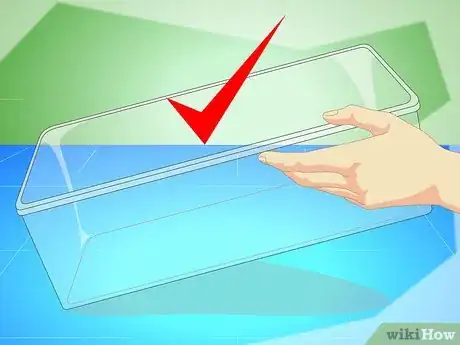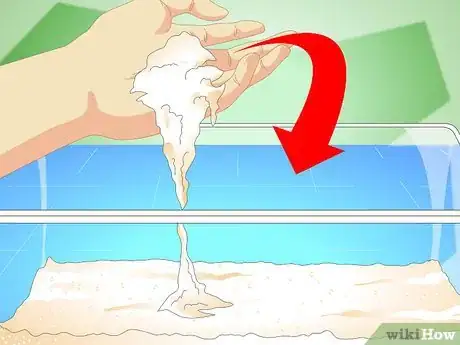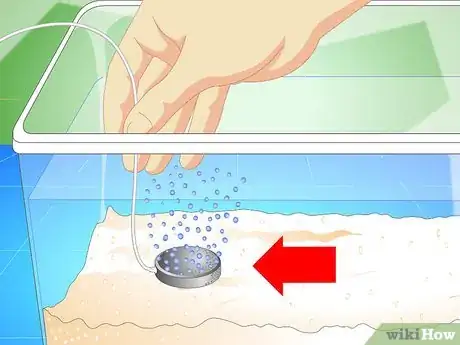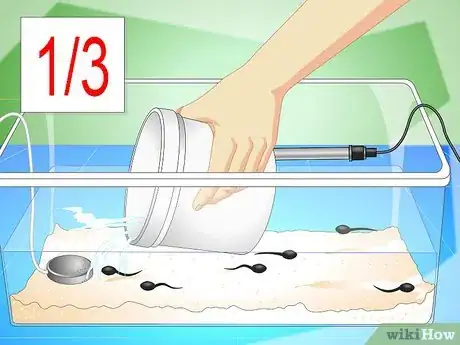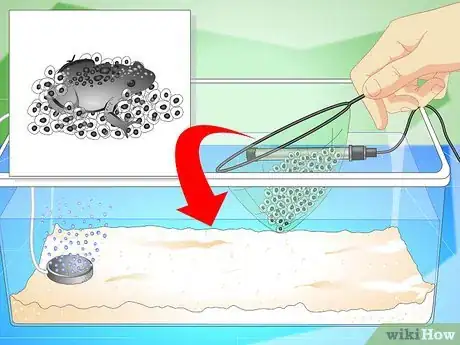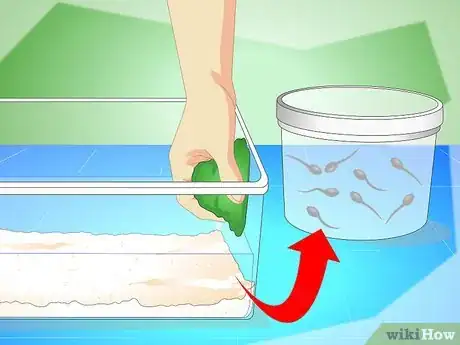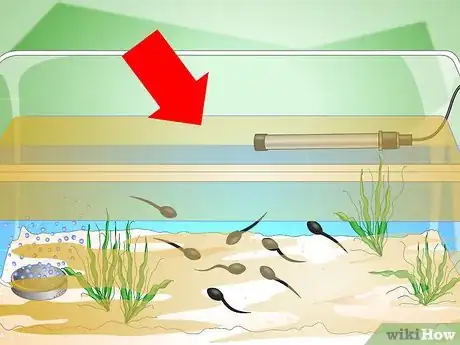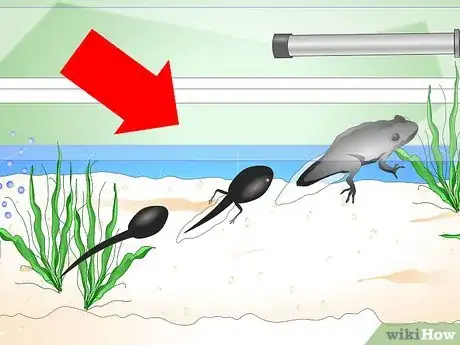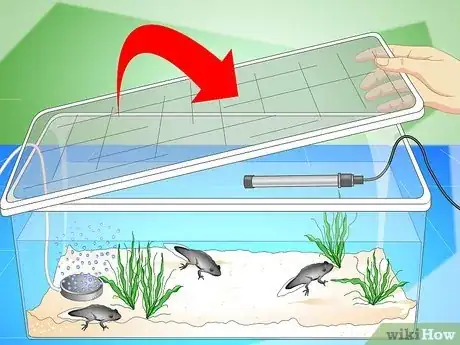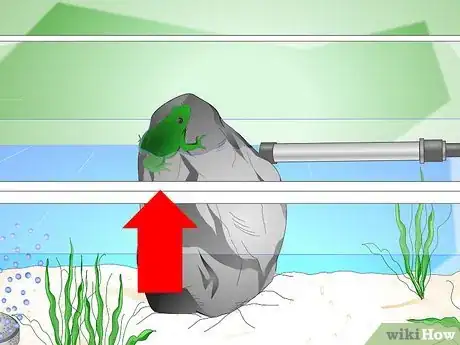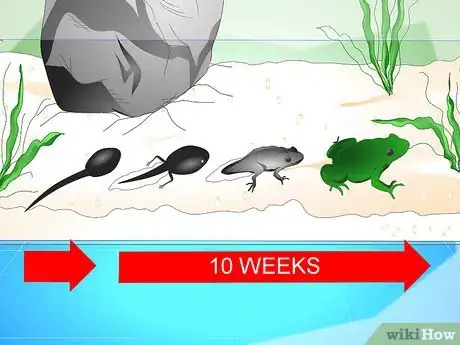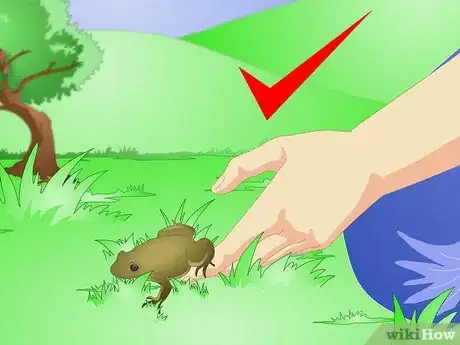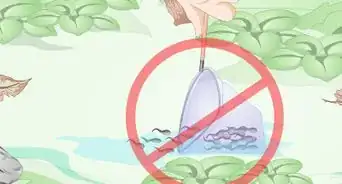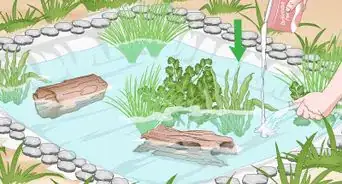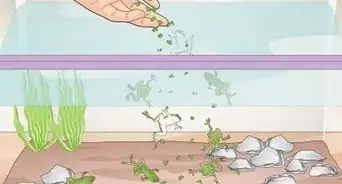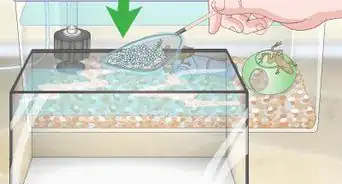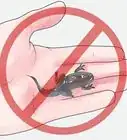This article was co-authored by Pippa Elliott, MRCVS. Dr. Elliott, BVMS, MRCVS is a veterinarian with over 30 years of experience in veterinary surgery and companion animal practice. She graduated from the University of Glasgow in 1987 with a degree in veterinary medicine and surgery. She has worked at the same animal clinic in her hometown for over 20 years.
wikiHow marks an article as reader-approved once it receives enough positive feedback. In this case, 93% of readers who voted found the article helpful, earning it our reader-approved status.
This article has been viewed 34,856 times.
Watching tadpoles grow is a good way to teach the process of metamorphosis to children, either at home or in the classroom. Caring for your tadpoles means providing a habitat that is as much like the tadpoles' natural habitat as you can. The common frog tadpole is native to the United Kingdom, and can be found throughout ponds, streams and lakes throughout Europe.
Steps
Preparing a Habitat
-
1Get a container to use for a habitat. The best container will be rather short and shallow, rather than deep. Having a wide top allows more air to be exposed to the air, allowing oxygen into the water. Good containers can be purchased at most pet stores, and are good for small numbers of tadpoles. You can easily reuse a container of your own, however.[1]
- A plastic container will be easiest to move. Glass containers are not recommended, as they may break. Metal containers, including those covered with enamel or porcelain, should not be used.
- Make sure your plastic container hasn't been used to carry or store chemicals, which may damage your tadpoles.
- If you have the space, plastic molded "kiddie" pools can provide a good living container for many tadpoles.
-
2Consider using sand in your habitat. Tadpoles generally enjoy having sand on the bottom of their container. As they often feed on microbials (small life forms) found with the sand, this makes it a good choice. However, having sand in your habitat will make it more difficult to keep clean.[2]
- River sand is best, as it doesn't contain salt (which is a problem with beach sand)
- If you are getting sand from the beach, make sure to rinse it multiples times to remove any trace of salt from the sand.
- You may also use rocks in the base of your habitat. Very tiny, round rocks can be purchased at many pet stores. Never use sharp-edged rocks, larger pebbles, or glass, as these can damage your tadpoles.
Advertisement -
3Fill your container with water. Unpolluted pond water or fresh rain water is ideal. Never use water straight from the tap, as it may contain chemicals that are hazardous to growing tadpoles. Make sure you use enough water: "best practice" is to use 1 liter per tadpole.
- Tap water may be used only if it's been allowed to sit for at least 3 days, so that any harmful chemical will have evaporated. Don't use tap water containing fluoride unless you can treat it with reverse osmosis or another special water filter which specifically says it removes fluoride.
- If you live in an area where rainwater is scarce, use bottled spring water, distilled water, or water treated with reverse osmosis.
-
4Provide ways to provide oxygen for the tadpoles. The two best ways to do this are to have an aerator which adds air into the water, or to grow leafy plants within the habitat. Good choices of plants are those which grow entirely under the water, have a long, stringy growing habit, and lots of small leaves along the length of the stem.[3]
- If you will be collecting tadpoles from a stream, having a gentle aerator running in your habitat is a good way to provide oxygen.
- If you'll be transporting the tadpoles from a stagnant pond, an aerator may be too disruptive.
-
5Keep water at an even temperature. The ideal temperature for common frog tadpoles is between 59° and 68° (15°C and 20°C). If your outdoor temperatures will make this difficult to maintain, you'll need to be able to keep your tadpole habitat inside.
- If the temperature rises above this, pollution can be a problem.
- To raise the temperature in your tadpole habitat, you may need to invest in an aquarium heater. Hanging heaters in glass tubes are the most common, but nonbreakable heaters in titanium or stainless steel can also be purchased.
- To lower your tank's temperature, try positioning a fan that blows air across the water's surface. This will also increase evaporation, so make sure that you're replacing the lost water as your water cools.[4]
- You can also freeze water in plastic bottles and place these bottles inside your tadpole habitat. This functions as ice cools liquid in a glass.
-
6Keep temperatures consistent. If you can, remove only about 1/3 of the water from the tank as you clean it. Take care when scooping out the water and refill slowly so that the tadpoles and any material on the bottom does not get churned up.[5]
- If you need to, create another container with fresh rain water in it and gently scoop up the tadpoles with a cup or net, and deposit them into the new tank.
- The water you're bringing the tadpoles from should be about the same temperature as the water you're bringing them to.
- Transitions between different temperature water can result in shock and death.
Caring for Your Tadpoles
-
1Collect frogspawn. You can easily capture all the frogspawn (frog eggs) you want to raise from a local pond, lake or stream. Bring a net or a bucket to this water source. When you arrive at the prepared habitat, use a small mesh net to collect and transfer the frogspawn.[6]
- Make sure you can put the frogspawn directly into their new habitat.
- Raise the tadpoles separately from other aquatic animals. They should get their own habitat.
-
2Watch for frogspawn to hatch. When tadpoles are first hatched, you should have a quantity of fresh pond weed, partly as food and partly as support for young tadpoles. Dried stinging nettle leaves crushed into a fine powder can also be fed to the young tadpoles.
- Scatter the pond weed and nettle leaves across the surface of the water.
- Tadpoles eat only vegetarian fare until their legs start to grow.
-
3Feed your tadpoles. Tadpoles in the wild normally feed on algae, but this may be difficult to find where you life. Feeding each tadpole two tablespoons of boiled lettuce or spinach is a good substitute for algae. Vegetarian fish flakes are another option, but avoid any fish flakes that incorporate animal byproducts. You should feed your tadpoles twice a day, once in the morning and once in the afternoon.[7]
- Add two crushed rabbit food pellets to supplement the diet of each tadpole. You don't need to feed them this more than once a day.
- Twice a week, you can add some hardboiled egg yolk to their diet to provide protein.
-
4Ensure that your tadpoles get sufficient calcium. Calcium is necessary to build the young bones of your tadpoles. The easiest way to do this is to add 2 drops of liquid calcium per liter of water, or 4 drops per gallon.[8]
- Read the label carefully to make sure it doesn't contain additives that may be harmful to your tadpoles.
- Adding a piece of cuttlebone (a sea shell) to the tank will also provide a nice, natural source of calcium.
-
5Clean your tank frequently. You'll know that the water needs changing if you notice a cloudy appearance or unpleasant odor to the water. Watch for tadpoles lingering near the surface or waste settling at the bottom of the tank. Make sure that any new water is the same temperature as the water already in the tank– drastic changes in water temperature can kill your tadpoles.[9]
- To clean your tank, you will need to have a second location where you can keep the tadpoles while you clean the inside of their tank.
- If your water isn't very dirty, you can leave the tadpoles in their habitat, while removing about a third of the water.
- Never use commercial cleaning products, which may contain harmful chemicals
- A clean tank will help prevent your tadpoles from getting infected or diseased.
-
6Look for signs of infection. Ranavirus is the most common virus to affect cold-blooded amphibians like tadpoles. Tadpoles affected by ranavirus may appear lethargic, or you might notice them swimming erratically, weakly, or on their sides.
- Bacterial infections are the main cause of death among frogs and tadpoles.
- The best way to prevent infection is to improve your tadpoles' immune system through proper maintenance of their habitat, nutritious food, and adequate oxygen.
- Signs of infection might be easiest to see by looking at the water. If you notice your water appearing cloudy yellowish-white, or a slimy series of bubbles all along the top of the water's edge, there's likely to be a higher chance of infection developing.
Watching Your Tadpoles Transition
-
1Watch for metamorphosis. The first signs of your tadpoles' development into a full-grown frog will be the front legs (or arms) starting to bud. Soon thereafter, the mouthparts completely change. The tadpoles' gills stop functioning and their lungs start to work, so that they can breathe air. The skin changes from a smooth and slimy skin to a rougher, porous skin which allows air and water through.[10]
- Internally, the tadpoles' intestinal tracks will change from the long intestine of a plant eater to the short intestine of a protein eater, which will comprise most of an adult frog's diet.
- You'll see limbs containing a skeleton grow out of a body which had no limbs or bones, as the tail muscle and fin deteriorates and is reabsorbed by the body.
-
2Put a lid on your tadpole tank. As your tadpoles develop limbs, they'll be at risk of making their way out of the tank. You'll want to prevent this from happening, both for the safety of your fledgling frogs and for your human habitat![11]
- The best lid will be well-ventilated, in order to let in fresh air while still keeping your frogs safely inside.
- A lid that attaches to the tank is best. Some commercial tanks come with snap-on lids, which work quite well.
-
3Put something the frogs can climb into the tank. While you want to make sure your new frogs don't get out of their tank, you'll also want them the opportunity to climb from the water and use their developing lungs to breathe air. A fat stick or a wide rock that rests on the base of the tank is a good choice.
- Once the frog starts to use its lungs to breathe, it's unable to use its gills. Without some way to climb out of the water, the frog may drown.
- Make sure the object is fixed, so that it can't move when the frog is on it.
-
4Know how long your tadpoles' metamorphosis will be. The common frog takes about 10 weeks to transition from tadpole to frog. At this point, the legs and lungs will have developed enough to allow the frog to emerge from the water.
- These new frogs are known as "metamorphs". The metamorph will continue to have a small tail for a short time before it is absorbed by the rest of the body.
- It will take the metamorph 2-3 years to reach breeding age.
-
5Know when it's time to release your tadpoles. When your tadpoles have developed arms and legs, it's time to let them go back into the wild. Ideally, you'll be able to release your frogs back into the same area from which you took them. If you can't do this, make sure you're releasing them into an area in which the common frog is commonly found.[12]
- If you aren't sure what variety of frog you've raised, check with an expert before releasing your frogs into the wild.
- When you've identified your frogs, look at a frog guide to find out what habitat this species of frog typically prefers. Then locate a setting that will meet the needs of your new frogs.
Warnings
- Never purchase frog eggs or tadpoles from vendors of any kind. These may be non-native species which can carry pathogens or disease to local species.[13]⧼thumbs_response⧽
References
- ↑ http://www.frogsafe.org.au/ponds/raising_tadpoles.shtml
- ↑ http://www.frogsafe.org.au/ponds/raising_tadpoles.shtml
- ↑ http://www.frogsafe.org.au/ponds/raising_tadpoles.shtml
- ↑ http://www.tfhmagazine.com/aquarium-basics/temperature-control.htm
- ↑ http://www.frogsafe.org.au/ponds/raising_tadpoles.shtml
- ↑ http://mdc.mo.gov/conmag/1995/07/raising-tadpoles
- ↑ http://mdc.mo.gov/conmag/1995/07/raising-tadpoles
- ↑ http://www.frogsafe.org.au/ponds/raising_tadpoles.shtml
- ↑ http://www.amphibianark.org/pdf/Husbandry/Tadpole%20care%20sheet%20with%20guidelines.pdf
About This Article
To care for common frog tadpoles, you'll need to create a habitat for them, which you can do by filling a short and shallow plastic container with river sand and unpolluted pond water or fresh rainwater. Remember to add an aerator or leafy plants to the tank, so your tadpoles receive oxygen, and try to keep the water temperature even and consistent, ideally in the range of 59 to 68 degrees Fahrenheit. While tadpoles in the wild feed on algae, you can feed your tadpoles vegetarian fish flakes or two tablespoons of boiled lettuce, twice daily. As your tadpoles start to transition into frogs, provide them with something to climb on, like a fat stick or wide rock, so they can develop their lungs to breathe air. For more advice from our Veterinary co-author, including how to ensure your common frog tadpoles get sufficient calcium to build bones, scroll down!
